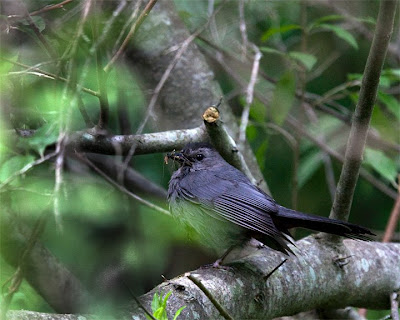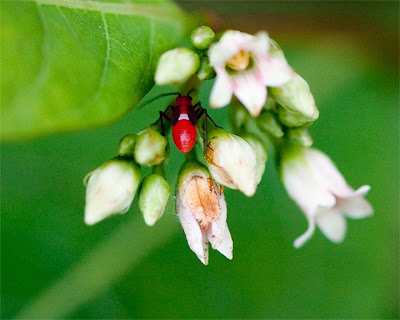
Chicory,
Cichorium intybus, is such a wonderful little plant. Its blanched leaves go well in salad; its roots make a decaffeinated coffee substitute; its flowers have this cool light sensitivity--they will close in afternoons or cloudy days.

At some point, I can envision Chicory becoming the subject of an in depth article. For now, let's just enjoy a wonderful excerpt from
The Philosophy of Common Life:"During the wars consequent on the French Revolution, when the commerce of our present allies was crippled, and France could with difficulty obtain colonial products, various substitutes for coffee were produced. Amongst these, the only one which attained celebrity, and became generally adopted, was the roasted and powdered root of the endive or chicory. So far as its sanitary merits go, the qualities of chicory are unobjectionable; notwithstanding various statements made to the contrary. Whether its mixture with coffee produces a beverage more or less agreeable than pure coffee to the taste, is altogether a matter of opinion; therefore, opinion ought to rule.
There appears no reason to interdict the use of chicory to chicory drinkers; even though the root should be employed unmixed with coffee, as is the practice in the neighbourhood of Manchester, and certain other parts of England. All who know what pure coffee is, and can appreciate the delicate flavour of that substance, need only whisper to himself a Spanish proverb—to the effect that "some tastes deserve whippings "—and let the chicory drinker, and the chicory dealer alone. There is every reason, however, wherefore a person who asks for coffee should obtain what he asks for. To violate this rule is to enact a falsehood. There are many reasons too for objecting to the practice, now legalised, of permitting the grocer to vend a mixture of chicory and coffee, in any relative proportion, at his pleasure. It would appear from the testimony of Mr. Phillips (the chemist, attached to the excise department of the inland revenue), given before Mr. Scholefield's committee—that it is legal for the grocer to sell a mixture of coffee and chicory, even though coffee be asked for; except the purchaser indicate his desires by some such specific formula as " pure coffee," or " coffee without chicory." I believe that the delicacy of palate necessary for appreciating the flavour of pure coffee is comparatively rare; and that the high-coloured, harsh-flavoured beverage resulting from chicory and coffee mixed, finds most general approval. Considering, then, the difference in price between chicory and coffue, the former being only worth some fourpence per pound, the introduction of chicory is a boon, provided the consumer be allowed to reap the benefit of the profit which accrues on the difference. Grocers and coffee-dealers have frequently been actuated by more expansive motives. Not content with allowing the chicory-loving part of the community to drink their chicory, they have endeavoured, by more than one device, to increase its sale. One ingenious person took out a patent for metamorphosing powdered chicory into the form of coffee berries. Others discovered that tin plate canisters retained the aroma of powdered coffee far better than paper. Attached to the discovery in question were certain collateral peculiarities. People could not break open a canister for the purpose of trying the quality of coffee within. Moreover, the canisters might be packed according to a sliding scale, chicory nearly pure at the bottom, coffee nearly unmixed with chicory at the top, on the principle, one may suppose, of gradually accustoming the palate to the transition from coffee to chicory. As to the detection of chicory, there are numerous methods. The most unfailing testimony of its existence is the microscope, of course; but nearly as certain, is the test of cold water, -which chicory powder immediately tinges of a ruddy colour; though coffee powder similarly treated scarcely imparts a perceptible shade of tint. However, he who cannot detect the presence of chicory by the taste alone may continue to drink it; thus increasing the amount of pure coffee to be drunk by those who know how to appreciate it."

Scofforn, John.
The Philosophy of Common Life. London, 1857. 95-7. Web.
Google Book Search. 26 June 2009.



















































